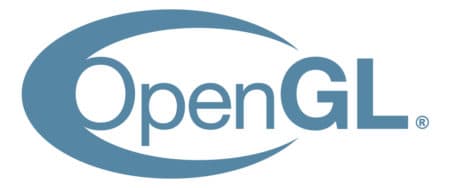The industry consortium known as The Khronos Group has released an important update to the widely adopted industry standard for computer graphics known as OpenGL. The group has released the OpenGL 4.6 specification with SPIR-V support.
OpenGL 4.6 with SPIR-V integrates the functionality of several ARB and EXT extensions created by Khronos group members like AMD, Nvidia, and Intel into the OpenGL core spec, including the ability to ingest SPIR-V™ shaders.
The Importance of SPIR-V
SPIR-V is an important industry standard created by The Khronos Group that liberates the use of a variety of shader languages for OpenGL-targeted development. “You are no longer just limited to glSL,” said Neil Trevett, president of the Khronos Group. SPIR-V is a standard intermediate language for parallel compute and graphics, which will allow software developers to simplify their shader authoring and management pipelines while providing greatly enhanced shading language flexibility.

01 – The Khronos Group has updated the industry-standard graphics API to OpenGL 4.6 with SPIR-V support.
OpenGL 4.6 adds support for ingesting SPIR-V shaders to the core specification, guaranteeing that SPIR-V shaders will be widely supported by OpenGL implementations. OpenGL 4.6 adds the functionality of these ARB extensions to OpenGL’s core specification:
- GL_ARB_gl_spirv and GL_ARB_spirv_extensions to standardize SPIR-V support for OpenGL
- GL_ARB_indirect_parameters and GL_ARB_shader_draw_parameters for reducing the CPU overhead associated with rendering batches of geometry
- GL_ARB_pipeline_statistics_
query and GL_ARB_transform_feedback_ overflow_query standardize OpenGL support for features available in Direct3D - GL_ARB_texture_filter_
anisotropic (based on GL_EXT_texture_filter_ anisotropic) brings previously IP encumbered functionality into OpenGL to improve the visual quality of textured scenes - GL_ARB_polygon_offset_clamp (based on GL_EXT_polygon_offset_clamp) suppresses a common visual artifact known as a “light leak” associated with rendering shadows
- GL_ARB_shader_atomic_counter_
ops and GL_ARB_shader_group_vote add shader intrinsics supported by all desktop vendors to improve functionality and performance - GL_KHR_no_error reduces driver overhead by allowing the application to indicate that it expects error-free operation so errors need not be generated
In addition to the above features being added to OpenGL 4.6, the following are being released as extensions:
- GL_KHR_parallel_shader_compile allows applications to launch multiple shader compile threads to improve shader compile throughput
- WGL_ARB_create_context_no_
error and GXL_ARB_create_context_no_ error allow no error contexts to be created with WGL or GLX that support the GL_KHR_no_error extension
“I’m proud to announce OpenGL 4.6 as the most feature-rich version of OpenGL yet. We’ve brought together the most popular, widely-supported extensions into a new core specification to give OpenGL developers and end users an improved baseline feature set. This includes resolving previous intellectual property roadblocks to bringing anisotropic texture filtering and polygon offset clamping into the core specification to enable widespread implementation and usage,” said Piers Daniell, chair of the OpenGL Working Group at Khronos. “The OpenGL working group will continue to respond to market needs and work with GPU vendors to ensure OpenGL remains a viable and evolving graphics API for all its customers and users across many vital industries.“
The OpenGL 4.6 specification can be found at https://khronos.org/registry/
Vulkan Interoperability Extensions
Sophisticated graphics applications will also benefit from a set of newly released extensions for both OpenGL and OpenGL ES to enable interoperability with Vulkan and Direct3D. These extensions are named:
- GL_EXT_memory_object
- GL_EXT_memory_object_fd
- GL_EXT_memory_object_win32
- GL_EXT_semaphore
- GL_EXT_semaphore_fd
- GL_EXT_semaphore_win32
- GL_EXT_win32_keyed_mutex
They can be found at: https://khronos.org/registry/
Broad Industry Support for OpenGL 4.6
“With OpenGL 4.6 our customers have an improved set of core features available on our full range of OpenGL 4.x capable GPUs. These features provide improved rendering quality, performance and functionality. As the graphics industry’s most popular API, we fully support OpenGL and will continue to work closely with the Khronos Group on the development of new OpenGL specifications and extensions for our customers. NVIDIA has released beta OpenGL 4.6 drivers today at https://developer.nvidia.com/
“OpenGL 4.6 will be the first OpenGL release where conformant open source implementations based on the Mesa project will be deliverable in a reasonable time frame after release. The open sourcing of the OpenGL conformance test suite and ongoing work between Khronos and X.org will also allow for non-vendor led open source implementations to achieve conformance in the near future,” said David Airlie, senior principal engineer at Red Hat, and developer on Mesa/X.org projects.
About OpenGL
OpenGL® is the most widely adopted 2D and 3D graphics API in the industry, bringing thousands of applications to a wide variety of computer platforms. It is window-system and operating-system independent as well as network-transparent. OpenGL enables developers of software for PC, workstation, and supercomputing hardware to create high-performance, visually compelling graphics software applications, in markets such as CAD, content creation, energy, entertainment, game development, manufacturing, medical, and virtual reality. OpenGL comprehensively exposes the features of the latest graphics hardware.
About The Khronos Group
The Khronos Group was founded in 2000 to provide a structure for key industry players to cooperate in the creation of open standards that deliver on the promise of cross-platform technology. Today, Khronos is a not for profit, member-funded consortium dedicated to the creation of royalty-free open standards for graphics, parallel computing, vision processing, and dynamic media on a wide variety of platforms from the desktop to embedded and safety critical devices. Khronos APIs are key technologies in their respective markets, such as Vulkan and OpenGL in graphics and gaming, WebGL in 3D web graphics, and OpenVX and OpenCL in embedded vision and compute.
The Khronos Board and all of its Working Groups are made up of Khronos members: universities and companies large and small from across the ecosystem. These members work together to define, document, maintain, and promote innovative APIs, file formats, and other open standards used throughout a cross section of industries.



Reader Comments
Comments for this story are closed